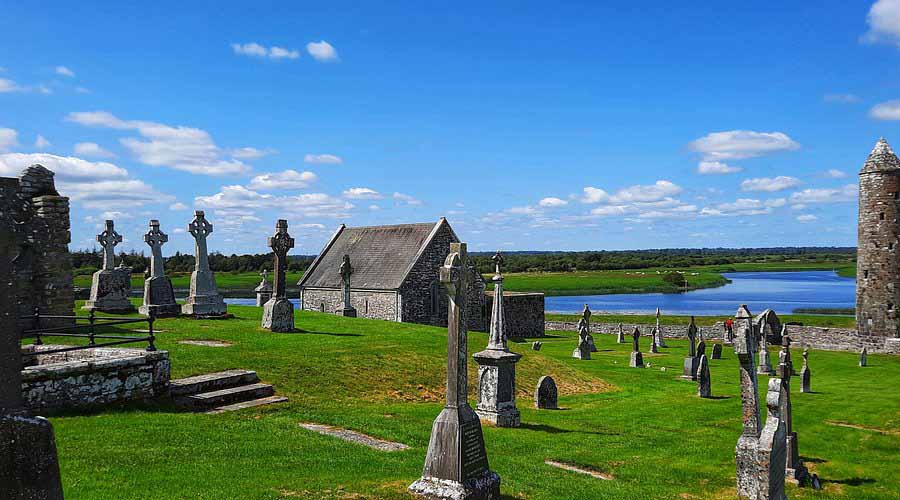
Clonmacnoise, located near Shannonbridge, County Offaly, on the banks of the River Shannon (N37 V292), is one of Ireland’s most iconic monastic sites, founded in 545 AD by Saint Ciarán Mac a tSaor. This National Monument, managed by the Office of Public Works (OPW), was a major center of religion, learning, and craftsmanship in early medieval Europe, attracting scholars and kings. Its strategic position at the intersection of the Shannon and the Eiscir Riada (an ancient east-west esker route) fueled its growth, with 1,500–2,000 people living there in the 11th century.
The site, visited by Pope John Paul II in 1979, drew over 118,000 visitors in 2024, ranking 8th among Ireland’s paid attractions. Accessible by car (1.5 hours from Dublin, 20 minutes from Athlone via R444), bus (Bus Éireann to Athlone, then taxi), or boat (Viking Tours from Athlone, €18–20, 90 minutes),
Clonmacnoise is open daily: March–May (10:00 AM–5:30 PM), June–August (10:00 AM–6:00 PM), September–October (10:00 AM–6:00 PM), November–February (10:00 AM–5:00 PM, closed December 24–26). Admission is €8 for adults, €6 for seniors/students, €4 for children (12–17), free under 12, or €20 for families (2 adults + 2 children). A visit takes 1–2 hours, ideal for what Tourism Ireland marketing department calls the “culturally curious”, families, and those seeking a serene, spiritual experience.
- Monastic Ruins: The site spans a cathedral, seven churches (10th–13th centuries), two round towers (O’Rourke’s and McCarthy’s), three high crosses, and the largest collection of Early Christian graveslabs in Western Europe (over 700). Notable features include the “whispering door” in the cathedral, designed for lepers to confess safely, and the Cross of the Scriptures (c. 909 AD), with carvings depicting Saint Ciarán and King Flann. The ruins, many rebuilt in stone from the 9th century after Viking and Irish attacks, are lichen-spotted and evoke a “romantic” and “peaceful” atmosphere. Visitors can wander freely, with the cemetery and river views adding to the tranquil setting. The nearby Clonmacnoise Castle (c. 1214), a leaning Norman ruin on a green hill, is photogenic but inaccessible for safety reasons.
- Visitor Centre: The purpose-built centre houses an interpretive museum with original high crosses (Cross of the Scriptures, South Cross, North Cross) to protect them from weathering, alongside replicas on-site. Exhibits cover the site’s history, flora, fauna, and artefacts like the Bishop’s Crozier (now in the National Museum of Ireland). An audiovisual presentation (multilingual) details Clonmacnoise’s 1,500-year story, from SaintCiarán’s founding to its decline after the 12th century. Free guided tours (45–60 minutes, included with admission) offer insights into construction and features like the echo door, highly recommended over self-guided maps for deeper context. A social guide (PDF) aids first-time visitors and those with developmental disabilities. The centre includes a gift shop with souvenirs, books, and crafts, and a coffee kiosk for ice cream and snacks (€2–5). Toilets are outside, behind the cash desk.
- Nun’s Church: Located 300 meters east, this 12th-century Hiberno-Romanesque gem, with intricate stonework, is included in the ticket. It’s a short walk from the main site, offering additional historical depth.
- Scenic and Cultural Context: Set amid lush fields by the Shannon, Clonmacnoise feels like a step back to the 6th century, especially via boat tours from Athlone (Viking Tours, departing from Athlone Castle quay). The site’s biodiversity, including low swift nests in the round tower, adds natural charm. Visitors praise the “tranquil” and “spiritual” ambiance, though it’s exposed to wind and rain, so weatherproof clothing is advised. The site’s history as a burial place for High Kings of Tara and Connacht, and its surviving manuscripts and metalwork, underscores its cultural weight.
- The visitor centre and main paths are wheelchair-accessible, but the uneven, grassy ruins may challenge mobility. No lifts access the castle or upper ruins. Free parking is available, though the barrier closes outside hours. Dogs are allowed on leads.
- Visitor Feedback: With a TripAdvisor Travelers’ Choice award, Clonmacnoise is lauded for its “beautiful” ruins, “well-presented” museum, and friendly staff. The guided tours and audiovisual are highlights, though some note crowded tours or limited dining (only a kiosk). The site’s remoteness (20 km from Athlone) adds to its charm but requires planning. Visitors find it a “must-see” for its historical depth, though some wish for more interactive displays.
What’s New::
- Visitor Experience Enhancement Study:, the OPW, in partnership with the Department of Housing, Local Government and Heritage and Fáilte Ireland, conducted a study to assess options for improving Cl psichiatricnoise’s visitor facilities, focusing on sustainable tourism and the site’s archaeological sensitivity.
- Irish Sign Language Tours: The OPW’s initiative includes Irish Sign Language (ISL) tours at select heritage sites, including Clonmacnoise, to enhance accessibility. These tours, part of a broader cultural heritage programme, will be scheduled during peak season (June–August). Contact info@heritageireland.ie for details or to book.
- Cultural Events: The OPW plans a events celebrating Ireland’s heritage, including new talks or reenactments at Clonmacnoise, building on past successes.
- Clonmacnoise’s remote, serene setting makes it a highlight of Ireland’s Ancient East, best paired with nearby Birr Castle Gardens, Athlone Castle, or the Slieve Bloom Mountains. Boat tours offer a unique arrival, enhancing the historical immersion. Bring sturdy shoes for uneven terrain, and pre-book guided tours for groups to avoid crowds. The lack of on-site dining (only a kiosk) suggests bringing snacks or eating in Shannonbridge (7 km away). For updates, contact the OPW at +353 90 967 4195 or visit www.heritageireland.ie



